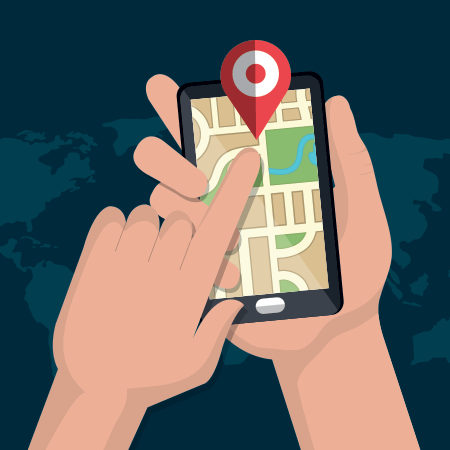What is Geofencing?
The name geo-fencing in itself explains a lot. Geofencing is a using radio frequency identification (RFID) or GPS technology to create a geographic fence or perimeter to target your audience. By using this location-based technology, businesses can connect with customers through their smartphones as the enter or leave a designated geographic area.
How does Geofencing work?
When using geofencing to advertise, a virtual geofence is created around a specific location from which the business wants to build their audience. This location could be a local, high-traffic area, an event, or even a competitor. When people enter the geo-fenced location during the established timeframe of the campaign (yes, you can even set it for specific times!), they will become a part of the targeted audience. They will then receive email alerts, app notifications or text messages, or depending on the type of campaign, see the business’s ads through various apps or mobile browsers for up to 30 days after entering the geofenced area.
There are a variety of ways to use this technology, but three basic types of geofencing:
- Location targeting – creating a geofence around a specific location such as your own business, a nearby street or area with high foot traffic, competitors, complimentary businesses, etc.
- Event targeting – creating a geofence around the location of an event at the time of an event that your potential customers may attend (concerts, sporting events, trade shows, etc.).
- Addressable geofencing - marketing to specific households or businesses from a mailing list. Addressable geofencing creates a virtual fence around each address and sends ads or messages to devices (cell phones, tablets, computers, streaming devices, etc.) within that geofence.
To make it a little clearer, let’s explore an example - a bakery that sells baked goods and creates wedding and special occasion desserts. This bakery could use geofencing to:
- Send a text to a first-time customer’s phone after they leave the bakery, thanking them for their visit and offering a discount on their next visit when they sign up for their email list/rewards program.
- Send alerts to customers in the area of the “treat of the day” to entice them to visit.
- Target visitors of a wedding dress store so they see ads from the bakery for customized wedding cakes.
- Send ads to customers of a competitor that show images of your desserts and offer a special
- Target attendees of a wedding expo so they see ads for your wedding cakes for the next 30 days.
- Combine your traditional marketing with addressable geofencing by using your mailing list to send out mailers as well as ads through geofencing of the Valentine’s Day specials.
With a little creativity and a little strategy, the possible advertising campaigns through geofencing are endless!
Why use geofencing?
In the age of smartphones, geofencing is highly effective. You can target your specific audience at specifics times, which allows you to market to true potential customers and not waste ad spend on general audiences, which is a smarter way to use ad spend and deliver advertising.
Geofencing also allows you to track those who see your ads and visit your business so you can measure your ROI. You can also easily modify your campaigns on the go. If users aren’t responding to your promotions, you can investigate what’s not working in your campaign and make appropriate changes.
Real Examples:
Interested in hearing how some big businesses have used geofencing in their ad campaigns?
Uber: Can you guess where Uber created their fences for their campaign? They set up fences around airports, hotels, night clubs, and more so that people would get notifications letting them know Uber drivers were nearby, right when they need them.
C.R. England: C.R. England, a transportation service, used geofencing to find truck drivers. They targeted places like truck stops to send their ads. Coupled with enticing ad copy, the geofencing campaign helped them receive more job applicants.
American Eagle: An apparel store, American Eagle used geofencing to increase sales for their factory outlets. Shoppers who had the American Eagle app received promotional ads as soon as they entered the outlet mall parking lot, which resulted in increased sales by three times.
Feeling inspired?
Next Steps:
Are you ready to optimize your advertising campaign to be more accurate and achieve a higher return on your investment? If so, geofencing is the perfect alternative for your business.
At SP Marketing, we use the most advanced location-based advertising technology designed to accommodate your specific campaign. You can utilize our geofencing advertising technology to customize your target audience with pinpoint accuracy and custom targeting shapes.
Begin your geofencing campaign today!
https://spmarketingexperts.com/optimize-your-advertising-with-geofencing/




